Brand New QNAP TS-h973AX NAS with Triple Tier ZFS Media Support
I have said it before and I will say it again, QNAP is the brand that you should look at when it comes to pushing innovation in the NAS industry. They were the first to introduce Thunderbolt NAS, fully-featured HDMI 2.0, DAS like connectivity into NAS over USB and more. However, the next TS-h973AX NAS that I want to discuss today is very much QNAP in their element. Using the triple-tier storage system that they have been refining year on year since 2017 across numerous product families, it arrives with three very different storage media bays, spread across 9 Bays (5+2+2), AMD Ryzen architecture, huge external connectivity options and even the ZFS file system. That last point will be of particular interest, given that some of the core caching, compression and storage tiering advantages of ZFS will be greatly enhanced by the hardware architecture on offer here. So, today I want to talk about the newly revealed desktop 5+ Bay NAS device from QNAP and help you decide if this server deserves your data.
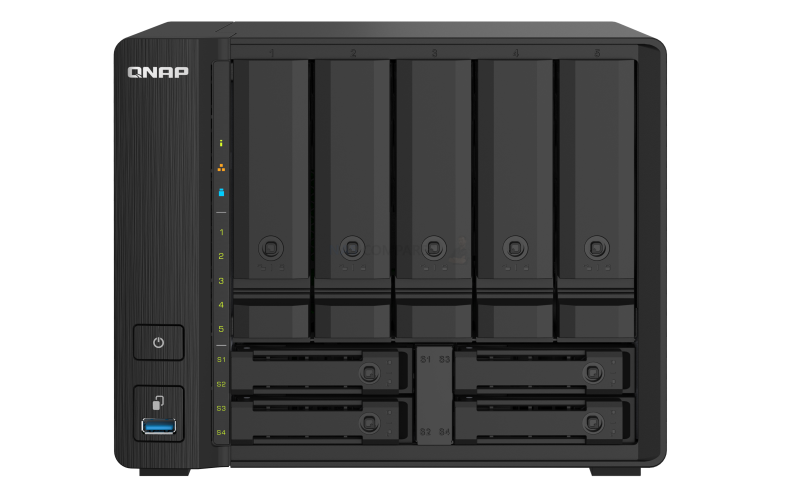
QNAP TS-h973AX NAS – Hardware Specifications
As already highlighted, the QNAP TS-h973AX arrives with a unique 3 tier storage system that allows you to take advantage of the benefits of each tier either in an intelligent system managed storage system (with tiers that handle different files types as their priority demands automatically). The first tier is the five SATA 3.5″ HDD (and SSD if you like) bays, supporting up to the latest 16TB and 18TB NAS hard drives from Seagate Ironwolf and WD Red. The 2nd Tier is two 2.5″ SATA SSD Bays that support up to the latest 4TB and 8TB solid-state drives. Finally, there are the (very unique for a product at this level) two U.2 NVMe SSD bays that can support huge capacity, super-fast SSDs from Intel, Samsung, Seagate and WD. Using the tiering, compression and caching options available in QuTS Hero, you have a system here that will seemingly get the very, VERY best internal performance internal that the storage can provide.
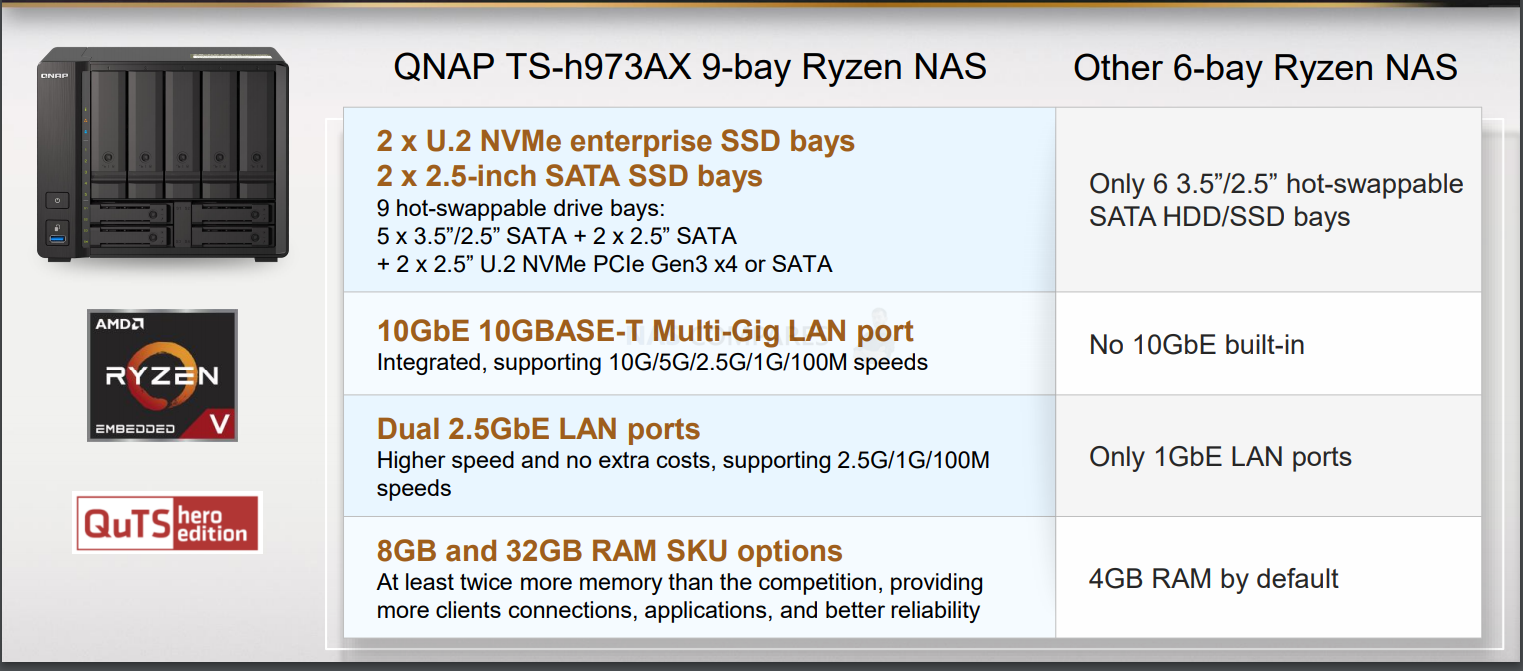
Alongside this, the TS-h973AX also arrives with the AMD Ryzen based V1500B quad-core processor, which is a 64bit x86 architecture processor that, although not featuring embedded graphics, DOES support all of those applications that need a good calibre processor (Surveillance with QVR Pro, Virtual Machine deployment in Virtualization Station, Ubuntu VMs in Linux Station and more). Finally, along with these great internal hardware confirmed specs, there is the external ports and connections. I am pleased to confirm that the TS-h973AX arrives with 1x 10GBASE-T (copper) 10Gbe AND 2x 2.5Gbe ports. So, a total network communication of 15Gb/s (1,500MB/s+) potential across transfers and connections. Below is a summary of all the specifications we know:
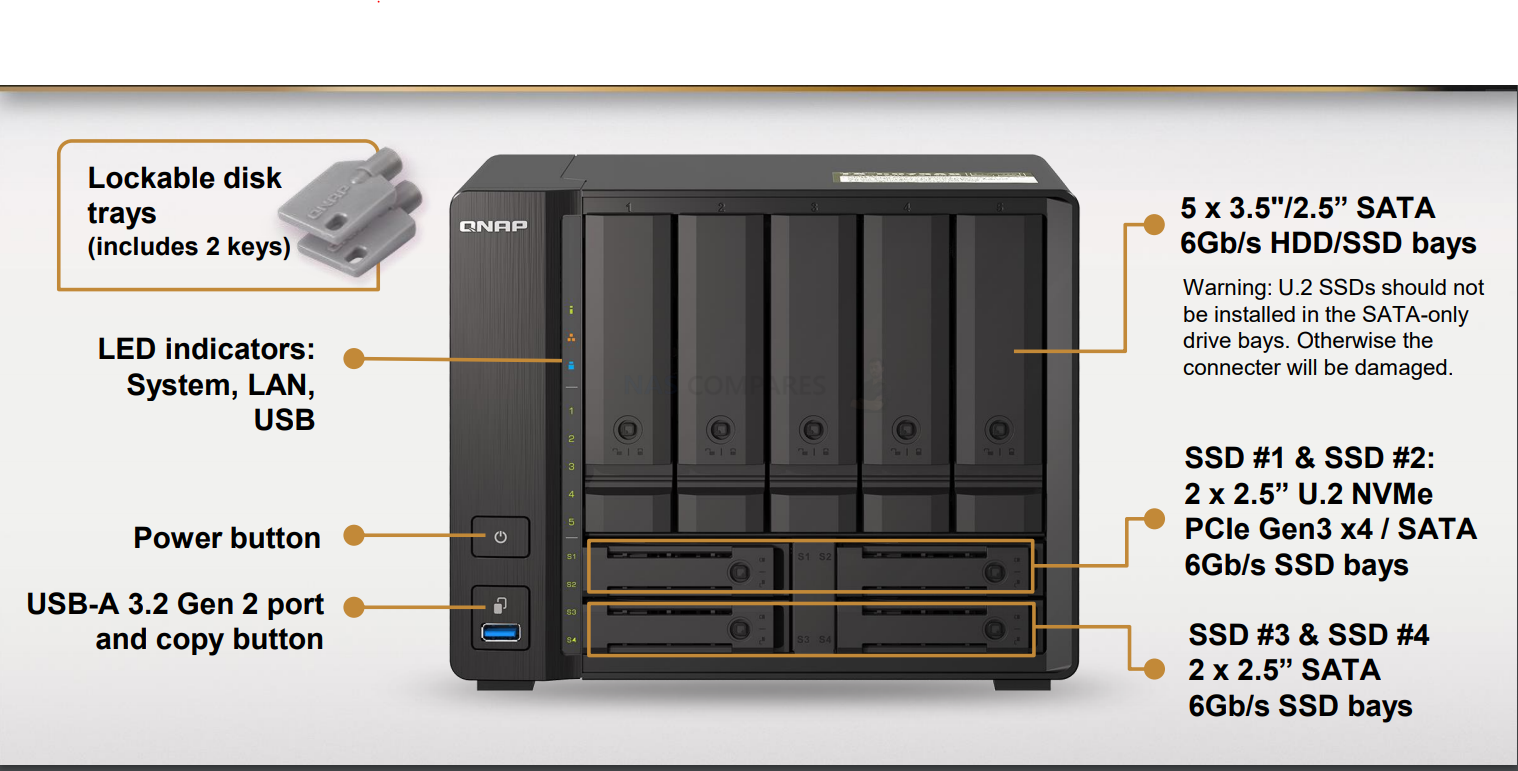
- AMD Ryzen V1500B Processor
- Quad Core 2.2Ghz
- Upto 32GB DDR4 2666Mhz SODIMM Memory
- 5x SATA 3.5″ Screwless Hard Drive Bays
- 2x U.2 NVMe PCIe Gen 3 x4 SSD Bays
- 2x SATA 2.5″ SSD Bays
- USB Ports for External Storage and numerous TL/TR Expansion devices
- All media bays are lockable
- 1x 10Gbe 10GBASE-T (Copper) Port
- 2x 2.5Gbe 2.5GBASE-T Ports
- 120W External PSU
It’s a very interesting and impressive hardware setup for such a compact device at 182.7 × 224.7 × 223.6mm and could be the most well equipped (in terms of storage) 5 HDD NAS I have ever seen. I am looking forward to seeing how the system can leverage the capacity/IOPS/Performance/price-per-TB of each storage tier against one another. Also, although U.2 NVMe SSDs (over generations using a SAS/MULTI SAS interface) may seem a rather ‘out of reach’ interface for many small/medium business users, it’s actually quite simple to use traditional NVMe SSDs inside this device, using the £60 QNAP QDA-UMP NVMe-to-U.2 adapter.
This allows you to still use PCIe Gen 3×4 NVMes, install them in the heatsink chassis and then install 1-2 in the TS-h973AX easily. Remember, this NAS does NOT force you to use the two SSD layers only for caching, and you can create a complete storage pool and volume on each media tier, which is something that video editors wanting to edit over 10Gbe on those U.2 will appreciate, allowing the SATA SSD for raw Photo editing over 2.5/5Gbe and finally the HDDs are there to run as archive storage. You can use numerous programs in the QNAP QuTS Hero app centre to create the perfect, bespoke multi-tiered backup solution that includes NAS, Cloud, USB and more.
QNAP TS-h973AX NAS – Software Specifications
The software found with the QNAP TS-h973AX NAS can be broken down into 2 sections. namely those of the advantages that QNAP QTS already bring to a business user, and then the widespread system and storage advantages that QTS hero and ZFS bring as well. For those unfamiliar with the QNAP operating system, it arrives with hundreds of free applications, can be accessed from a web browser or desktop client, arrives with many, many apps for mobile on IOS and Android and is definitely in the top two operating systems you can get for network-attached storage devices. Often compared with their biggest rival Synology NAS and DSM, QNAP QTS GUI is designed in a way that will definitely appeal more to Android and Windows users, giving you everything you will need from a network-attached storage device in 2020 and arrives with constant updates for added features and security.
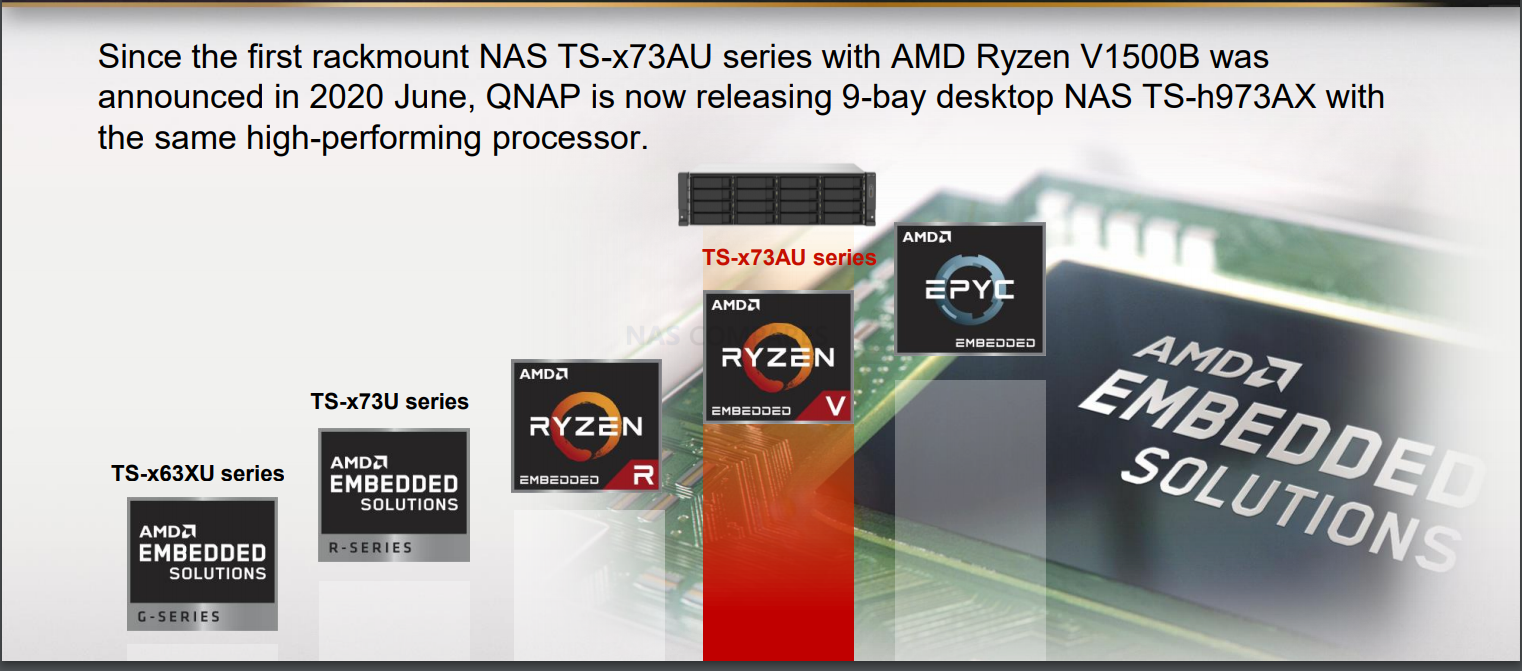
QNAP File Management Highlights
- File Station – File Browsing and Management Tool
- QSirch -Intelligent and Fast System-wide search tool
- QFiling – Smart and customizable long term storage and archive tool
- SSD Caching Monitor and Advisor – Allowing you to scale your SSD cache as needed, or get recommendations on how much you need
- QTier – The QNP intelligent, multi-layer tiering system that works to optimize your SSD and caching configuration
- Microsoft Active Directory– Support and cross-platform control of Active Directory processes
- Access-Anywhere with myQNAPcloud – Safe and secure remote access over the internet to your storage systems, apps or just file storage
- Qsync for multiple hardware environment backups and Sync – Client applications that can be installed on multiple 3rdparty devices and create a completely customizable and scaled backup network between your devices
- QuDeDupe / Deduplication tools – Allowing you to conduct backups between multiple devices and directories, but allows same-data in numerous locations to be only held once (but recorded in all locations) to allow smaller backups and lesser bandwidth consumption
Then you have KEY applications that are used on the QNAPNAS system that moves into tailored data access and use, such as:
- Hybrid Backup Sync 3 – Allows you to Backup and Sync with Amazon Glacier, Amazon S3, Azure Storage, Google Cloud Storage, HKT Object Storage, OpenStack Swift, WebDAV, Alibaba Cloud, Amazon Drive, Amazon S3, BackBlaze B2, Box, Dropbox, OneDrive, Google Drive, HiDrive, hubiC, OneDrive, OneDrive For Business, ShareFile and Yandex Disk. As well as backup to another NAS over real-time remote replication (RTRR) and USB connected media. All scheduled and all accessible via a single app user interface.
- vJBOD and Hybrid Mount – Gives you the ability to mount cloud storage as a visible drive within the NAS (and the apps access it as if it was local) or mount a % of space from your NAS onto another as a virtual chunk of space to use
- Multimedia Console – one portal access point to manage media access, searching, indexing and transcoding on your NAS device.
- Photo, Video and Music Station – Multiple file type tailored applications to access data in the best possible way that is suited to their output – along with smart searching, playlists and sharing
- Virtualization Station – Used to create virtual computers that can be accessed anywhere over the network/internet with the correct credentials. Supporting Windows, Linux, Android and more. You can import an existing VM image to the NAS, or you can even download Linux and Windows VMs directly to the NAS for trials for free
- Container Station – much like the VM app, Container station lets you mount and access smaller virtual tools and GUIs, then access them over the network or internet.
- Linux Station – Handy application to deploy multiple Linux based Ubuntu VMs from the NAS, all easily and within a few clicks
- QVR Pro and Surveillance Station – Surveillance applications that allow you to connect multiple IP cameras and IP speaks to your network and manage them with the applications. Arriving with 4 camera licenses for Surveillance Station and 8 licenses for QVR Pro (the better one IMO), QNAP is constantly updating this enterprise-level surveillance application – adding newer security hardware and software tools for 2020 (see QVR Face and QVR Door)
- QuMagie – Facial and Thing recognition application to help you retrieve, tag and catalogue photos by its use of AI to actually ‘view’ all your years of photos and let you search by the contents of them, not the file names.
- Download Station – A download management tool that can handle HTTP, BT, FTP and NZB files in bulk to be downloaded to your NAS drive and keep safe. As well as keeping an eye on your RSS feeds and keeping your podcast downloads automatically updated with every episode
- Malware Removers and Security Councillor – Along with Anti Virus software trials on the app centre, QNAP also provide numerous anti-intrusion tools and even a whole app interface to monitor in/outgoing transmissions with your NAS. It can make recommendations to beef up your security and keep you safe
Above are a few of my software overviews that cover the general GUI and system of QuTS Hero on the TS-h886, as well as RAID rebuild and storage management overviews of the system to give you some idea of what the TVS-x88X can and cannot do:
Space Saving Efficiency – Inline data deduplication, compression, and compaction reduce file size to conserve storage capacity and optimize performance.
Intelligent Memory Cache – Main memory read cache (L1 ARC), SSD second-level read cache (L2 ARC), and ZFS Intent Log (ZIL) for synchronous transactions with power fail protection are simultaneously supported to boost performance and security
RAID Z – Multiple RAID levels allow flexible capacity utilization. RAID Triple Parity and Triple Mirror deliver higher levels of data protection.
QSAL (QNAP SSD Antiwear Leveling) – RAID-level SSD lifespan is automatically and regularly detected to prevent simultaneous SSD failure, improving your data protection and system reliability.
App Center – Apps for backup/sync, virtual machines/containers, content management, productivity, and more features can be used to expand the application potential of the TS-h973AX.
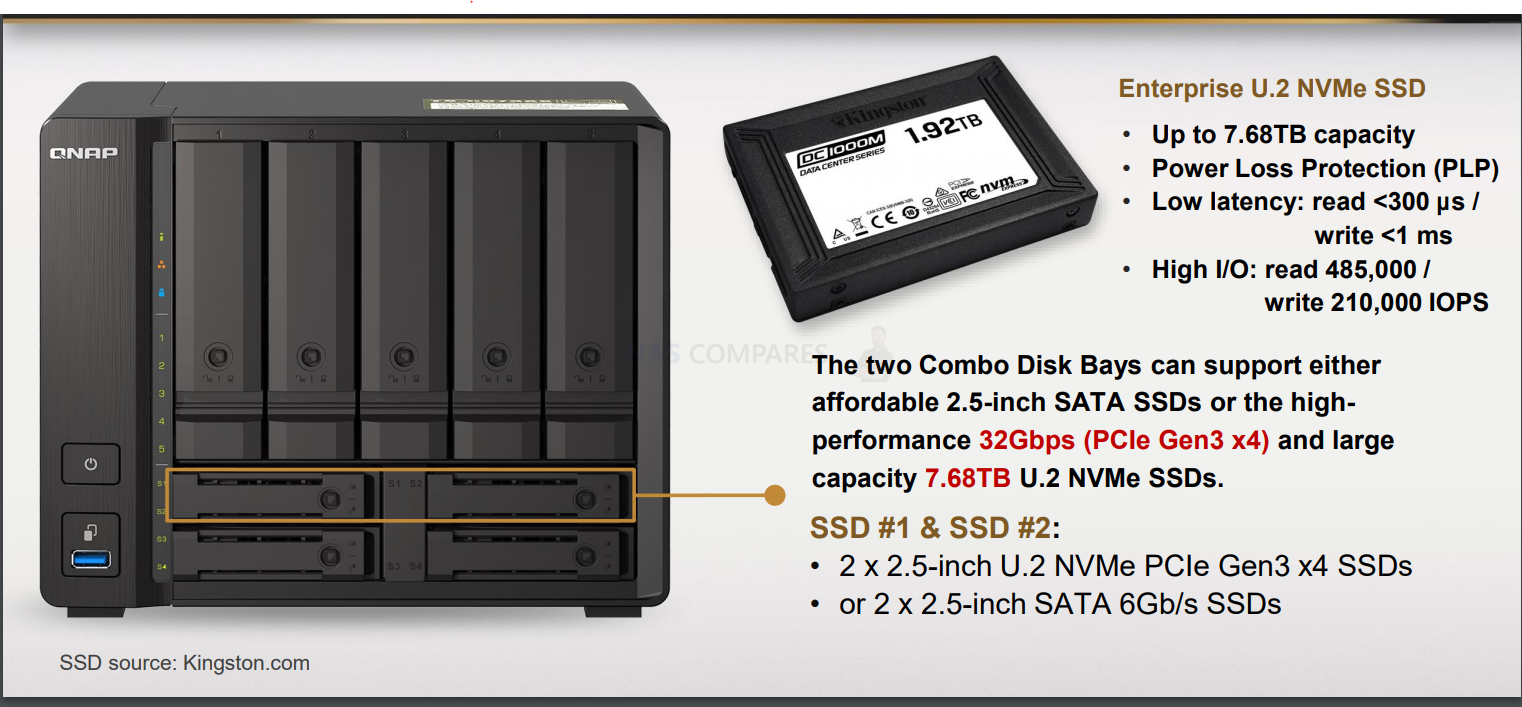
QNAP TS-h973AX NAS – Price & Release
Details about pricing and worldwide release are a little thinner on the ground. The QNAP 73AX and 73AU ranges have slowly been releasing/to-be-released towards the end of 2020, but the TS-h973AX is quite different from those, as although it DOES have the same CPU architecture, the surrounding triple tier media support, external bandwidth and ZFS QuTS Hero support are something that only this device arrives with. I think we will likely see this right at the tail end of 2020, but can imagine stock will be limited in the early stages. For those of you that have been looking at modern NAS solutions in 2020 (and towards 2021 of course) that provide a solid even split between storage, power and speed, I can imagine the QNAP TS-h973AX ticks a whole lot of boxes for you, so I would recommend pre-ordering if this seems like a good solution for your business needs. Regarding price, that’s a whole lot tricker. Previous generations of the 5HDD+4SSD combo from QNAP (eg the TVS-951X, TS-963N and TS-932X) have always arrived at a price point around 100-150 more than their general 4-Bay HDD Only counterparts. However in the TS-h973AX, we find a huge amount of unique features and hardware (ZFS, U.2, 10G, etc) that is leaps above the likes of the TS-x73AU series (generally starting around £750+ ex.VAT). Likely you are looking at £1000-1100, but even then, this is a large amount of guesswork and likely does not include your local tax.
📧 SUBSCRIBE TO OUR NEWSLETTER 🔔🔒 Join Inner Circle
Get an alert every time something gets added to this specific article!
This description contains links to Amazon. These links will take you to some of the products mentioned in today's content. As an Amazon Associate, I earn from qualifying purchases. Visit the NASCompares Deal Finder to find the best place to buy this device in your region, based on Service, Support and Reputation - Just Search for your NAS Drive in the Box Below
Need Advice on Data Storage from an Expert?
Finally, for free advice about your setup, just leave a message in the comments below here at NASCompares.com and we will get back to you. Need Help?
Where possible (and where appropriate) please provide as much information about your requirements, as then I can arrange the best answer and solution to your needs. Do not worry about your e-mail address being required, it will NOT be used in a mailing list and will NOT be used in any way other than to respond to your enquiry.
Need Help?
Where possible (and where appropriate) please provide as much information about your requirements, as then I can arrange the best answer and solution to your needs. Do not worry about your e-mail address being required, it will NOT be used in a mailing list and will NOT be used in any way other than to respond to your enquiry.

|
 |
Beelink ME Pro NAS Revealed
Best SOLID STORAGE NAS of 2025
Should You Worry About the NanoKVM Hidden Microphone?
Best Cheap NAS of 2025
Minisforum MS-02 Ultra - WHO IS THIS FOR??? (The First 48HRs)
Why People Use TrueNAS, UnRAID and Proxmox to Turnkey NAS (Synology, QNAP, etc)
Access content via Patreon or KO-FI
Discover more from NAS Compares
Subscribe to get the latest posts sent to your email.


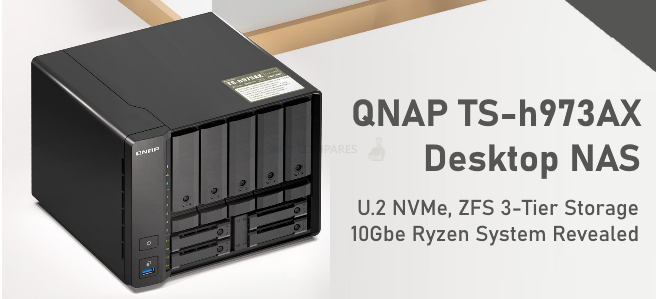



Quick question. Can you expand RAID configurations across extensions with both TL and TR units? I suppose this is highly discouraged because if one NAS unit fails, the whole raid goes to shit but I’m just curious if it can be done and how would it perform. Are there any videos on your channel on this topic?
I suppose that if you connect both units to the same UPS, it should not be a problem, right?
REPLY ON YOUTUBE
Old video, but I’ve got a question (noob here). Can the TL-D800C be used as a simple hard drive enclosure as-is? As-in, slot in 8 drives in it then plug the USB cable onto a Windows 10 PC and the PC would detect those drives like external/internal hard drives?
Asking because I’ve been looking for a mass storage solution but would just like it to be simple via USB and where I can just add drives when it gets full. I don’t really want to go through all the trouble of setting up RAID setups or network arrays as it’s mostly for personal use anyway, but I have a lot of stuff (mainly backups of my games and media), and I would like to reduce my external HDD clutter.
REPLY ON YOUTUBE
Can someone answer a question I have? Qnap says to put the system drive on two ssds on a Nas with only two ssds. Does that mean I can’t have a cache Drive?
REPLY ON YOUTUBE
Can you get the JBOD expansion unit and format it with RAID0 in macOS? Or is it locked to JBOD?
REPLY ON YOUTUBE
RAID5/6 is NOT ZFS RAID!
REPLY ON YOUTUBE